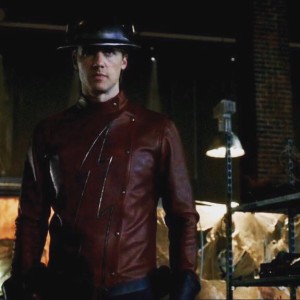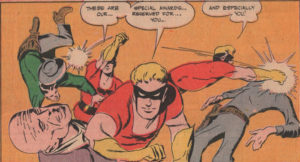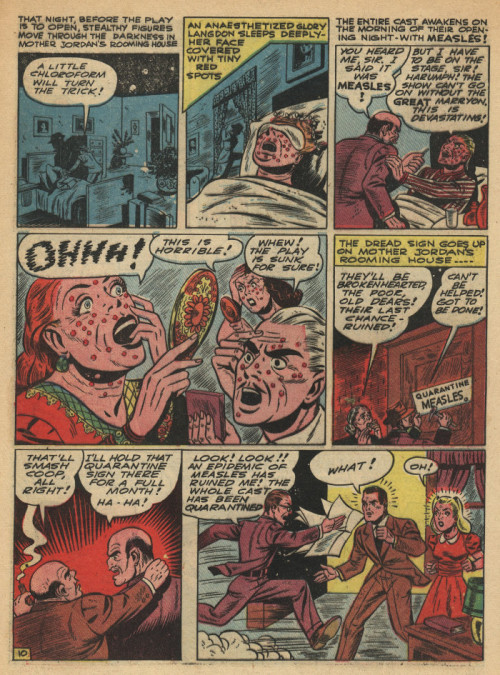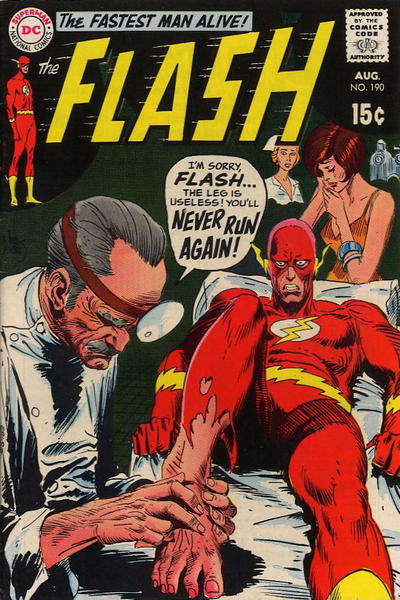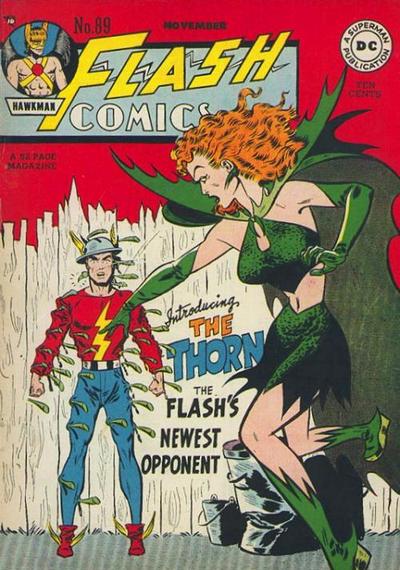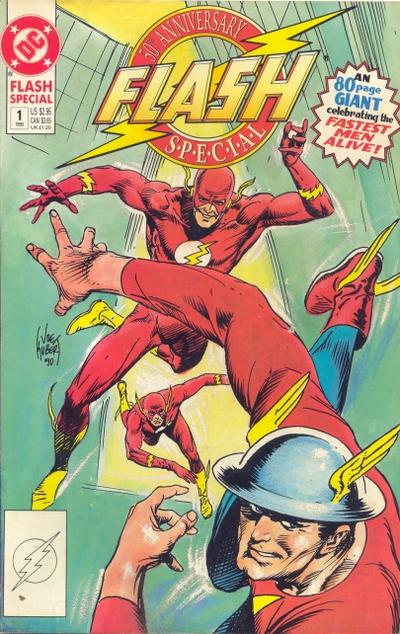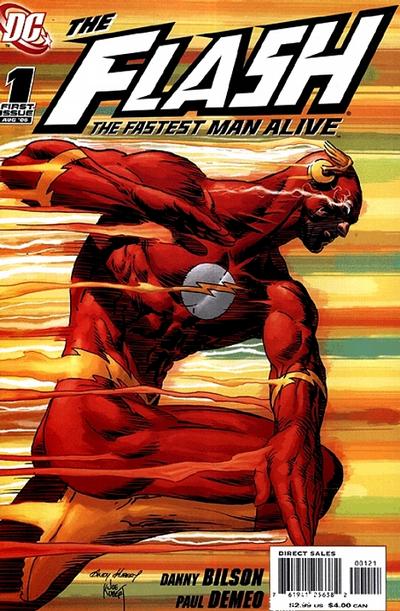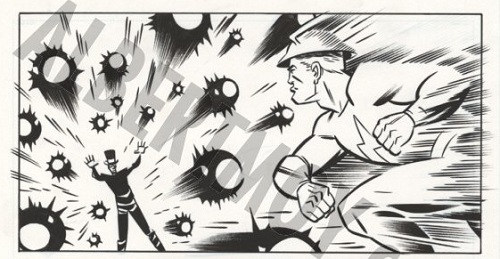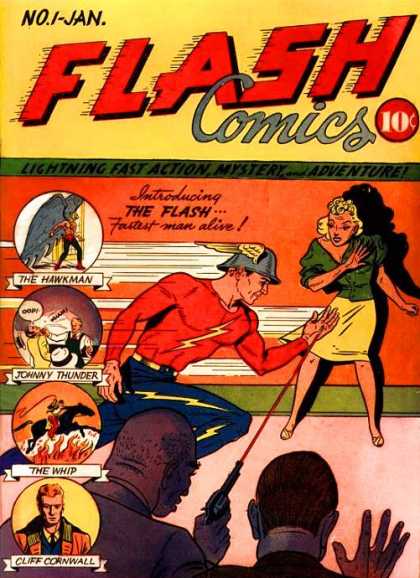Jay Garrick, the Flash of an alternate reality, debuts in the second season of the Flash TV show. He may be coming to the CW second, but he’s actually the first scarlet speedster to wear the lightning in DC’s earliest comic books.
Golden Age
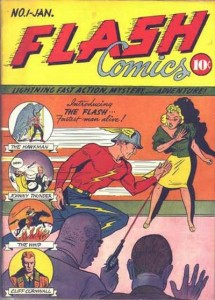 Way back in 1940, Jay Garrick [character bio] made his debut in the iconic Mercury-style winged helmet. Back then “Flash Comics” was an anthology book, and he traded off the cover spot with Hawkman each month. But the Flash was popular enough he soon got his own series, appropriately called “All-Flash.”
Way back in 1940, Jay Garrick [character bio] made his debut in the iconic Mercury-style winged helmet. Back then “Flash Comics” was an anthology book, and he traded off the cover spot with Hawkman each month. But the Flash was popular enough he soon got his own series, appropriately called “All-Flash.”
Jay Garrick was a scientist working in the private sector, not rich but well enough off as time went on that he could move within society circles. He told his college girlfriend Joan Williams about his secret right away, and she quickly became his lifelong confidante. She was less likely to get into trouble and need saving than she was to find people who needed help and point them toward the Flash.
In the 1940s he mostly fought gangsters and corrupt businessmen in Keystone City. It was several years before the Thinker appeared, and back then he was simply a criminal mastermind. Super-villains didn’t really start to show up in their modern form until the end of the decade, and even then they still had henchmen as often as powers. The stories ranged from serious crime tales to out-and-out slapstick comedy, especially when a trio of Three Stooges lookalikes joined the supporting cast. It wouldn’t be remotely out of place for the Flash to pelt a criminal with rotten tomatoes or tie him to a lamppost in his underwear.
Superheroes fell out of favor toward the end of the decade, and the Flash faded from view. DC went for an experimental reboot in 1956, introducing police scientist Barry Allen. Jay Garrick might have been forgotten, except…
Silver Age Multiverse
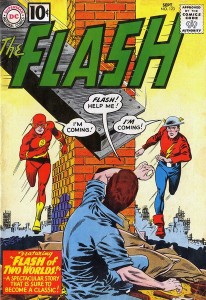 In 1961’s Flash #123’s “Flash of Two Worlds” introduced DC’s version of the multiverse. DC’s current stories were said to take place on Earth-One, and the older stories were said to take place on Earth-Two. Barry Allen crossed over, met Jay Garrick, and teamed up for what became a regular tradition.
In 1961’s Flash #123’s “Flash of Two Worlds” introduced DC’s version of the multiverse. DC’s current stories were said to take place on Earth-One, and the older stories were said to take place on Earth-Two. Barry Allen crossed over, met Jay Garrick, and teamed up for what became a regular tradition.
Over the next few decades, Jay Garrick was a regular guest star in The Flash. Sometimes he’d visit Barry on Earth-One. Sometimes Barry and Wally would visit Earth-Two.
And something unusual happened: Because Earth-Two wasn’t DC Comics’ main setting, they allowed time to pass. Jay Garrick and Joan Williams married. Other heroes from the Justice Society had children, and those children grew up to become super-heroes themselves.
Elder Generation
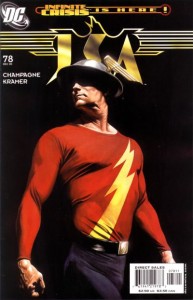 In 1985, DC Comics rebooted again, combining characters from various timelines into a single history. Because Jay Garrick, Barry Allen and Wally West were distinct characters, they all got to be part of the new history instead of being collapsed into a single younger character. Other heroes’ pasts were rewritten and combined. The Flashes were simply placed on opposite sides of a river instead of in alternate realities.
In 1985, DC Comics rebooted again, combining characters from various timelines into a single history. Because Jay Garrick, Barry Allen and Wally West were distinct characters, they all got to be part of the new history instead of being collapsed into a single younger character. Other heroes’ pasts were rewritten and combined. The Flashes were simply placed on opposite sides of a river instead of in alternate realities.
DC quickly shuffled the Justice Society offstage after Crisis on Infinite Earths, but after a few years they brought them back… and the original heroes of the DCU became mentors to a new generation. Jay Garrick, once a brash youngster who wisecracked at costumed crooks while throwing pies at them, grew into an elder statesman, training younger superheroes.
New 52 / Society
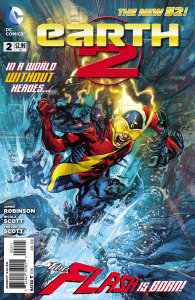 Everything changed in 2011 when DC rebooted once again in the wake of Flashpoint. Jay Garrick and Barry Allen no longer share a planet. Jay once again lives on Earth-2, and we’re reading the adventures of a much younger hero on a world recovering from a devastating interstellar war.
Everything changed in 2011 when DC rebooted once again in the wake of Flashpoint. Jay Garrick and Barry Allen no longer share a planet. Jay once again lives on Earth-2, and we’re reading the adventures of a much younger hero on a world recovering from a devastating interstellar war.
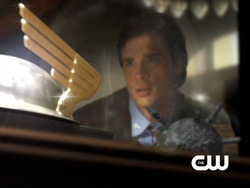
Media
Teddy Sears is the first actor to portray Jay Garrick in live action, but this isn’t the first time the character has appeared on TV. He’s shown up on the cartoon Batman: The Brave and the Bold, and he was name-checked (along with a cameo of his helmet) when Smallville revealed a secret history of super-heroes. When Smallville continued as a comic book, they tracked Jay down to help Impulse (Bart Allen), and he came out of retirement to teach a new generation of heroes in Smallville: Titans.
It seems he just can’t get away from the mentoring gig!
